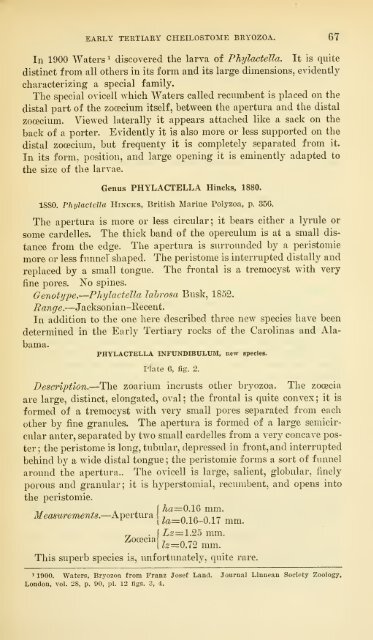Bulletin - United States National Museum - Smithsonian Institution
Bulletin - United States National Museum - Smithsonian Institution
Bulletin - United States National Museum - Smithsonian Institution
You also want an ePaper? Increase the reach of your titles
YUMPU automatically turns print PDFs into web optimized ePapers that Google loves.
EARLY TERTIARY CHEILOSTOME BRYOZOA. 67<br />
In 1900 Waters ^ discovered the larva of Phylactella. It is quite<br />
distinct from all others in its form and its large dimensions, evidently<br />
characterizing a special family.<br />
The special ovicell which Waters called recumbent is placed on the<br />
distal part of the zooecium itself, between the apertura and the distal<br />
zocecium. Viewed laterally it appears attached like a sack on the<br />
back of a porter. Evidently it is also more or less supported on the<br />
distal zocecium, but frequenty it is completely separated from it.<br />
In its form, position, and large opening it is eminently adapted to<br />
the size of the larvae.<br />
Genus PHYLACTELLA Hincks, 1880.<br />
1880. Phylactella Hincks, British Marine Polyzoa, p. 356.<br />
The apertura is more or less circular; it bears either a lyrule or<br />
some cardelles. The thick band of the operculum is at a small dis-<br />
tance from the edge. The apertura is surrounded by a peristomie<br />
more or less funnel shaped. The peristome is interrupted distally and<br />
replaced by a small tongue. The frontal is a tremocyst with very<br />
fine pores. No spines.<br />
Genotype.—Phylactella lalrosa Busk, 1852.<br />
Range.—Jacksonian-Recent.<br />
In addition to the one here described three new species have been<br />
determined in the Early Tertiary rocks of the Carolinas and Alabama.<br />
PHYLACTELLA INFUNDIBULUM, new species.<br />
Plate 6, fig. 2.<br />
Description.—The zoarium incrusts other bryozoa. The zooecia<br />
are large, distinct, elongated, oval ; the frontal is quite convex ; it is<br />
formed of a tremocyst with very small pores separated from each<br />
other by fine granules. The apertura is formed of a large semicir-<br />
cular anter, separated by two small cardelles from a very concave pos-<br />
ter ; the peristome is long, tubular, depressed in front, and interrupted<br />
behind by a wide distal tongue ; the peristomie forms a sort of funnel<br />
around the apertura.. The ovicell is large, salient, globular, finely<br />
porous and granular; it is hyperstomial, recumbent, and opens into<br />
the peristomie.<br />
MeasureTnents.—Apertura ^<br />
, r> i r> a i t<br />
[ Za=0.16-0.17 mm.<br />
Z2=1.25 mm.<br />
Zoceciai , „ „„<br />
^^=0.

















